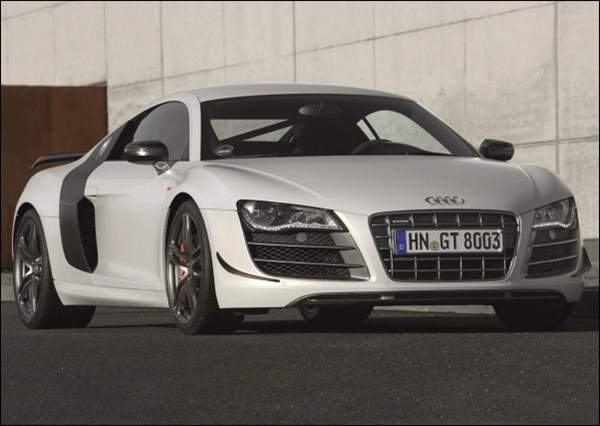2012 Audi R8 GT Goes Into Production—Limited Production
Audi has announced that they will be building just 333 Audi R8 GT models—worldwide.
#aluminum
Audi has announced that they will be building just 333 Audi R8 GT models—worldwide. And the company says that this is the “lightest, fastest and most powerful entry in the Audi supercar lineup.”
How fast? Well, they’re citing a top track speed of 199 mph and a 0 to 62 mph time of 3.6 seconds. And how fast is that? It takes about 3.5 seconds to read the headline and halfway through the first sentence of this piece.

The mid-engined 2012 Audi R8 GT is powered by a 5.2-liter V10 FSI engine that produces 560 hp—which is 35 hp more than the R8 Coupe 5.2 quattro and the R8 Spyder 5.2 quattro.
And while Audi is well known for its expertise in lightweight aluminum construction, they’re expanding their knowledge portfolio to carbon fiber. Consequently, the R8 GT, with carbon fiber used for such body parts as the rear hatch, spoiler, and diffuser, weighs about 180 lb. less than the Audi R8 Coupe 5.2 quattro.

And if you’re interested in this fast car, you’d probably act quickly: of the 333 to be produced, there are 90 slated for the U.S. market.
One more thing. The sticker price is $196,800 (not including the $1,250 destination charge, taxes, title, options, and dealer charges). But if you have to ask, you probably can’t afford it, anyway.
RELATED CONTENT
-
The Koenigsegg Jesko Has An Amazing Engine
It is hard to believe that this is a vehicle in “serial” production with such extraordinary powertrain performance
-
Jeeps Modified for Moab
On Easter morning in Moab, Utah, when the population of that exceedingly-hard-to-get-to town in one of the most beautiful settings on Earth has more than doubled, some people won’t be hunting for Easter eggs, but will be trying to get a good look at one of the vehicles six that Jeep has prepared for real-life, fast-feedback from the assembled at the annual Easter Jeep Safari.
-
Creating a Low-Cost Chassis Architecture
The engineers at Zenos Cars have combined recycled carbon fiber, drinking straws and aluminum to create a chassis for a low-volume sports car.


.jpg;width=70;height=70;mode=crop)






